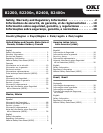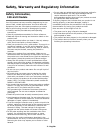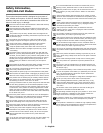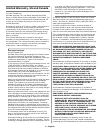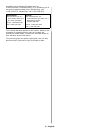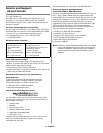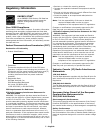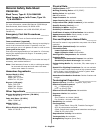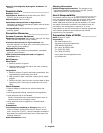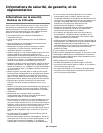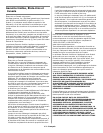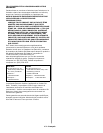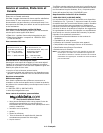
8 - English
Material Safety Data Sheet
#
58382301
Black Toner, Type X: P/N 43640301
Black Image Drum/with Toner, Type 11:
P/N 43650301
For more information, contact Oki Data at: 2000 Bishops
Gate Boulevard, Mount Laurel, NJ 08054-4620.
Emergency Information: call 1-800-654-3282; US and
Canada only.
Emergency First Aid Procedures ______
Toner inhaled.
Remove person to fresh air. Seek medical attention.
Toner swallowed (ingested)
Immediately seek medical attention. Never give anything by
mouth to an unconscious person. If possible, rinse out
mouth and give one or two glasses of water or milk to drink.
Toner gets in the eyes.
Flush eyes with large quantities of cool water for 15 minutes,
keeping the eyelids open with fingers. If necessary, seek
medical attention.
Toner gets on the skin.
Wash toner off the skin with plenty of cool water and soap. If
necessary, seek medical attention.
Note:
Small amounts of toner on skin or clothing can easily
be removed with soap and cold water. Hot water
makes toner harder to remove.
Hazardous Ingredients _____________
Carbon Black (4-8%)
CAS#: 1333-86-4.
OSHA TWA: 3.5 ppm.
ACGIH TLV: 3.5 ppm.
Styrene (<50 ppm)
CAS#: 100-42-6.
OSHA TWA: 50 ppm.
ACGIH TLV: 20 ppm.
Other Ingredients _________________
Styrene Acrylate Copolymer (70-90%)
CAS#: 25767-47-9.
Fatty Acid Ester (0-2.5%)
CAS#: 75587-84-7.
PMMA (0-3%)
CAS#: 9011-14-7
Silicon Dioxide (amorphous) (0-5%)
CAS#: 67762-90-7
Physical Data _____________________
Physical State:
Solid.
Melting/Freezing Point:
110°C (230°F).
Boiling Point:
Not applicable.
PH:
Not available.
Vapor Pressure:
Not available.
Vapor Density (Air=1):
Not available.
Evaporation Rate (Butyl Acetate=1):
Not available.
Specific Gravity (H
2
O=1):
1.15.
Solubility in Water:
Negligible.
Solubility in Solvents:
Not available.
Coefficient of water/oil Distribution:
Not available.
Appearance and Odor:
Black powder, no odor.
Odor Threshold: Not available.
Fire and Explosion Hazard Data _______
Minimal fire hazard. Large quantities may cause risk of dust
explosion.
Flash Point (Method Used):
Not available.
Flammable Limits
Lower Explosive Limit:
60 g/m
2
.
Upper Explosive Limit:
Not available.
Auto-Ignition Temperature
: Not available.
Explosion Data
Sensitivity to Mechanical Impact:
Not available.
Sensitivity to Static Discharge:
Not available.
Extinguishing Media:
Dry chemicals, CO
2
, water spray or
foam.
Special Fire Fighting Procedures:
Do not use methods
that may create a dust cloud, such as high pressure water
and/or steam. Avoid inhalation of smoke or gases. Wear
self-contained breathing apparatus.
Hazardous Combustion Products:
Oxides of carbon and
nitrogen.
Toxicological Properties_____________
Routes of Entry:
Inhalation, Ingestion, Eyes, Skin.
Effects of Acute Exposure:
LD
50
: >2000mg/kg (rat)
LC
50
: >4.98 mg/l (rat)
Effects of Chronic Exposure:
Not available.
Exposure Limits:
Not available.
Irritancy:
Skin Irritation: no irritant (rabbit)
Eye Irritation: minimal irritant (rabbit)
Sensitivity:
Not available.
Carcinogenicity
IARC: Carbon Black: Group 2B, "Possible Carcinogen."
NTP: No components are listed.
OSHA: Carbon black is designated hazardous according to
OSHA 29 CFR 1910.1200.
Reproductive Toxicity:
Not available.
Teratogenicity:
Not available.
Mutagenicity:
Negative (Ames Test).



